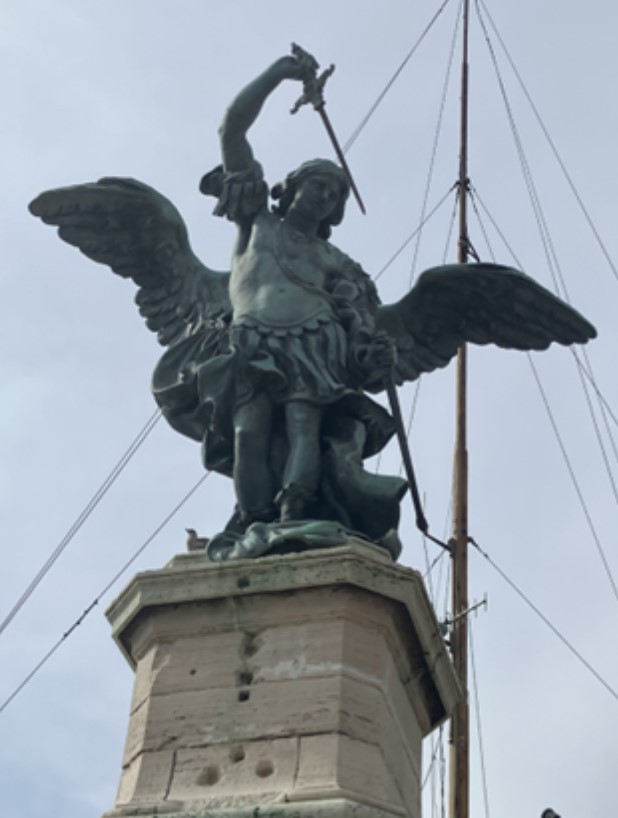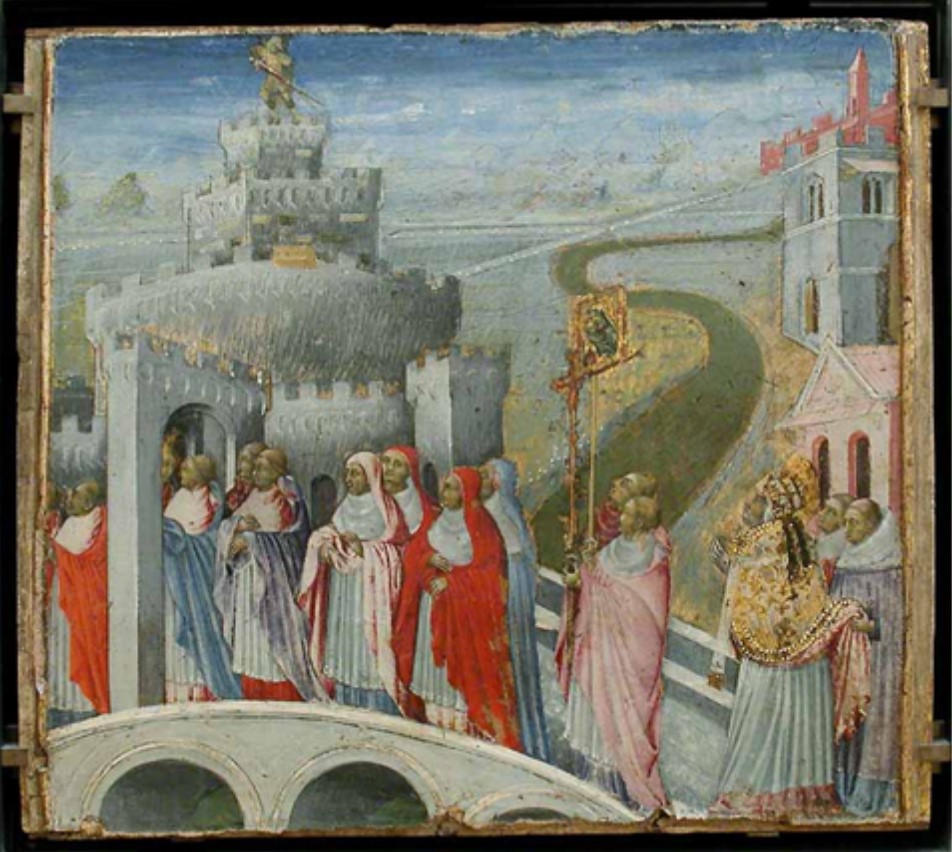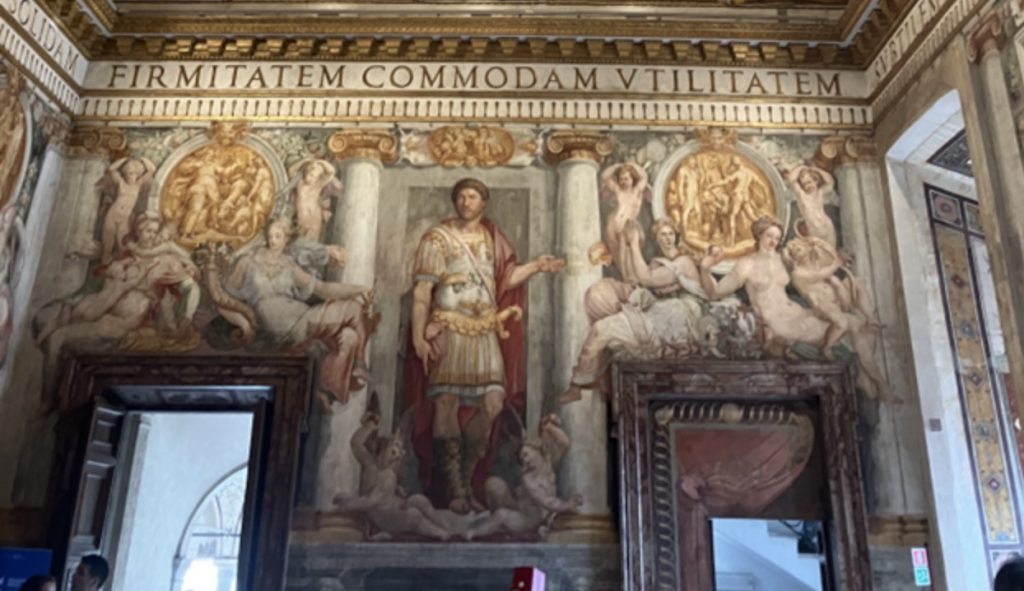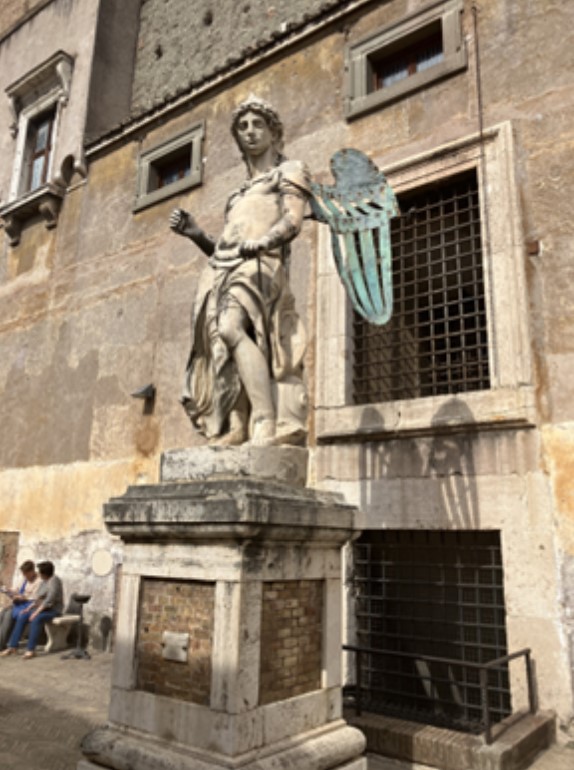Tags
BGSU History, BGSU Study Abroad, Casey Stark, Dylan Smith, Jo Enger Arthur Scholarship for Study Abroad, Roma Aeterna, Undergraduate
By: Dylan Smith, BGSU Roma Aeterna 2023 Student

One of Rome’s many great sites in Rome is the Mausoleum of Hadrian, now known as the Castel Sant’Angelo. Over the years, the Mausoleum has served a variety of purposes and housed the remains of many notable Roman Emperors and their families. Because the structure saw considerable use even after the fall of the Roman Empire and into the Medieval and Renaissance periods, the Castel Sant’Angelo remains in incredible condition when compared to many other notable ancient Roman sites such as the Roman Forum, Colosseum and more. The Castel Sant’Angelo has however changed immensely since its initial construction, with the changes reflecting its uses as a mausoleum, fortress stronghold, and even prison. During our study abroad trip, we had the chance to visit Castel Sant’Angelo and see its history up close.
The mausoleum’s mastermind, the Roman Emperor Hadrian, ruled from 117 CE until his death in 138. Hadrian is considered part of the Roman Empire’s “Five Good Emperors,” who ruled Rome in its Golden Age. Hadrian is best known for his large public works projects with this most famous being Hadrian’s Wall in Britain.
While his adopted father Trajan was concerned with expanding the Empire’s borders, Hadrian was concerned with fortifying the borders of the Roman Empire. Like his father Trajan, Hadrian was an experienced military man. Hadrian was the only emperor to travel to every single province in the empire. Along these travels, Hadrian inspected and improved the conditions of the Empire’s garrisons and camps. Hadrian’s most famous campaign came when led the attack on Judea to crush the Jewish uprising led by Bar Kokhba. Hadrian first ordered construction on the Mausoleum as a burial location for him and his family in 135 CE with the project led by the architect Demetrius. Hadrian, who died in 138 CE, would not live to see the tomb’s completion in 139 CE under the rule of Hadrian’s successor, Antonius Pius. The mausoleum was one of many large public works projects Hadrian was known for. According to the 4th century Roman history source, Historia Augusta, “He built public buildings in all places and without number, but he inscribed his name on none of them except the temple of his father, Trajan” (Historia Augusta). The mausoleum would go on to house the remains of many notable emperors, including Antonius Pius and Marcus Aurelius and Caracalla, who was the last emperor to be held in the mausoleum’s chambers.
The Castel Sant’Angelo is widely considered to be one of Rome’s great architectural masterpieces. The construction of the mausoleum featured a round large drum, which sat upon a square shaped foundation. Upon its construction, the mausoleum was ornately decorated with various fine marbles and intricate carvings and reliefs. The original western entrance was also connected with a large bridge that was first known as the Pons Aelian, which was constructed with statues depicting the Roman gods adorning each side. The top of the mausoleum featured a garden full of cypress trees with a massive colossal statue featuring four horses pulling a quadriga ridden by Hadrian fixed at the summit. The main holding chamber for burial remains is notable for its natural lighting. Two long diagonal passageways in the ceiling allow for sunlight to shine through and illuminate the area where the urns would have been. When the mausoleum was completed by Antonius Pius in 139 CE, a now lost inscription dedicated to Hadrian was added, which read “Imperator Caesar Aelius Hadrian Antoninus Augustus Pius, pontifex maximus, twice holder of tribunician power, twice consul, three times consul designate, Father of his country, for his parents, Imperator Caesar Hadrian Augustus, son of Divine Trajan Parthicus, grandson of Divine Nerva, pontifex maximus, with tribunician power twenty-two times, imperator twice, consul three times, Father of his Country and the divine Sabina.” While much of the Castel Sant’Angelo has been changed over the years, the main holding room has been preserved and remains in incredible shape.

In the twilight years of the Western Roman Empire, the mausoleum would see a variety of utilitarian uses, most notably as a fortress. The architecture of the structure, its strategic position on the Tiber River and its proximity to the Aurelian Walls made it the perfect base for a defensive position. In 401 CE, under the order of Flavius Honorius Augustus, the building was converted into a fortress and incorporated into the Aurelian walls. Throughout the fifth century, extensive renovations were made to the mausoleum to improve the structure’s defensive capabilities. The circular drum structure was expanded and fortified, a cone shaped roof was added, the walls were fortified and battlements were added throughout the structure. During this process, parts of the Mausoleum’s original artistry and detailing were destroyed or replaced as the mausoleum’s role became more military oriented. The renovations of the fifth century represented a shift in priorities for Rome as its power and wealth declined while outside threats grew in strength and number. Once ornate monuments representing imperial wealth and power, like the Mausoleum of Hadrian, would be repurposed for more utilitarian purposes.
As Rome found itself increasingly under attack, the Mausoleum would fall into disrepair. When Rome was sacked in 410 CE by Visogoth barbarians led by Alaric, the urns containing the ashes of the emperors were stolen and scattered. When Rome was sacked by the Ostragoths in 537 CE the statues adorning the top of the Mausoleum were toppled by the mausoleum’s defenders and dropped on the besieging Ostrogoths. During this turbulent era, much of the mausoleum’s original detail and artwork would be stolen or destroyed. Following the collapse of the Western Roman Empire at the hands of Gothic and Germanic invaders, the Mausoleum of Hadrian would change hands between noble families before eventually falling into the possession of the Papacy, who maintained control throughout the Medieval and Renaissance eras. Under Papal control, the Mausoleum would continue to see use as a fortress and stronghold, housing the Pope in times of danger due to its proximity to the Vatican. In certain circumstances, the Mausoleum also saw use as a prison, where inmates were supposedly left to starve to death. Under papal control, an underground tunnel connecting the Mausoleum to the Vatican was added so that Popes could take refuge in the castle when Rome was under attack.
During the Medieval era, the Mausoleum would undergo a major change in aesthetics and naming. In 590 CE, the city of Rome was stricken with deadly plague, which many interpreted as the wrath of God. In response, future Pope Gregory I led a series of religious processions along the Tiber River in the hope of some form of divine intervention or mercy. According to legend, when Gregory passed by the mausoleum of Hadrian, he was struck with a vision of the Archangel St. Michael. In Gregory’s vision, Michael stood atop the mausoleum brandishing a blood soaked sword, representing divine punishment from God, which according to some accounts was in response to the worship of pagan idols in Roman churches. Michael then wiped the blood from the sword and sheathed it, which Pope Gregory accurately interpreted as a sign that the plague would soon be over. In response to Gregory’s vision of St. Michael, the Mausoleum of Hadrian was renamed “Castel Sant’Angelo,” which translates to “Castle of the Holy Angel,” in reverence of the Archangel Michael’s appearance. Pope Gregory’s vision of St. Michael atop the mausoleum and the subsequent dedication to the Archangel’s miracle greatly elevated the religious importance of the Mausoleum and strengthened its ties to the Papacy.

The transformation of the mausoleum into a holy site had widespread impact on other sites in Rome. Following his encounter with Michael, Pope Gregory began targeting the worship of pagan religions, with many pagan temples and idols destroyed or relocated. As part of this effort, many Roman sites, notably the Roman Pantheon, would be reconfigured into churches and other spiritual sites. In the case of the Castel Sant’Angelo, the image of angels would become the dominant aesthetic, with the halls and rooms of the mausoleum redecorated with imagery of Michael and other angels. One of the most notable artistic additions was a large marble statue of the Archangel Michael, which was placed at the summit of the Castel Sant’Angelo. In the 16th century, the Aelian Bridge became the Ponte Sant’Angelo and ten statues of angels brandishing the instruments of the passion of Christ were erected, replacing the statues of the Roman gods. The most famous part of the Castel Sant’Angelo was added in 1753 when a massive bronze sculpture of the Archangel Michael sheathing a sword, designed by Peter Anton von Verschafftel, was placed on the summit of the Castel Sant’Angelo, replacing the older marble sculpture, which was moved to a new location within the castle. While angelic imagery now dominates the Castel Sant’angelo as a result of Michael’s appearance, traces of the structure’s original Roman roots do remain as busts and illustrations of Hadrian and other Roman emperors and religious figures can be found scattered throughout.

The long and storied history of the Castel Sant’Angelo continues even to this day with the Mausoleum now serving as a museum. While the appearance and structure of the Castel Sant’Angelo has changed drastically due to its many roles, influences from its Roman beginnings are still present alongside the more prominent Christian detailing. The Castel Sant’Angelo is emblematic of Rome’s religious evolution; while the statues and imagery of the Roman gods have mostly given way to the angels of Christianity, the Roman gods do maintain some limited artistic presence. The history and aesthetics of the Castel Sant’Angelo easily made it one of the most interesting and impressive destinations in our Roman adventure.

Works Cited
Barber, A. B., and Alta Macadam. 2020. “Rome: (Blue Guide).” Blue Guides Limited.
Boatwright, Mary Taliaferro. “HADRIAN’S MAUSOLEUM AND THE PONS AELIUS.” In Hadrian and the City of Rome, 161–81. Princeton University Press, 1987. https://doi.org/10.2307/j.ctv18zhd8v.13.
Di Paolo, Giovanni. Procession of St Gregory to the Castel. 1464, Louvre Museum, France.
Gallegos, Jose Carlos. “PONTE CASTEL SANT’ANGELO.” Litoral, no. 118/120 (1982): 77– 78. http://www.jstor.org/stable/43356311.
Smith, Dylan. Castel Sant’Angelo, Rome, Italy. 2023. Photograph of bronze statue of St Michael
the Archangel.
Smith, Dylan. Castel Sant’Angelo, Rome, Italy. 2023. Photograph of marble statue of St Michael
the Archangel.
Smith, Dylan. Castel Sant’Angelo, Rome, Italy. 2023. Photograph of Mural Featuring Emperor
Hadrian.
Smith, Dylan. Castel Sant’Angelo, Rome, Italy. 2023. Photograph of urn room
Testa, Judith. “Castel Sant’ Angelo: The Tomb by Many Other Names.” In Rome Is Love Spelled Backward: Enjoying Art and Architecture in the Eternal City, 45–51. Cornell University Press, 1998. http://www.jstor.org/stable/10.7591/j.ctv177tbsm.9.
Unknown. Historia Augusta. Translated by David Magie. Loeb Classical Library, 1952-1954.
Unknown. Lost inscription in the Mausoleum of Hadrian. 139 CE?, Rome, Italy.
